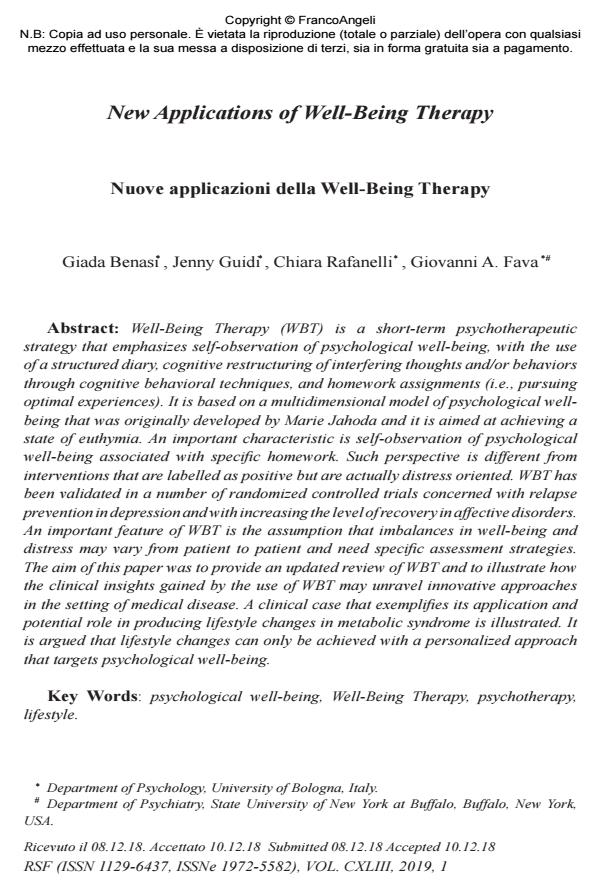New Applications of Well-Being Therapy
Titolo Rivista RIVISTA SPERIMENTALE DI FRENIATRIA
Autori/Curatori Giada Benasi, Jenny Guidi, Chiara Rafanelli, Giovanni A. Fava
Anno di pubblicazione 2019 Fascicolo 2019/1
Lingua Inglese Numero pagine 20 P. 87-106 Dimensione file 1827 KB
DOI 10.3280/RSF2019-001006
Il DOI è il codice a barre della proprietà intellettuale: per saperne di più
clicca qui
Qui sotto puoi vedere in anteprima la prima pagina di questo articolo.
Se questo articolo ti interessa, lo puoi acquistare (e scaricare in formato pdf) seguendo le facili indicazioni per acquistare il download credit. Acquista Download Credits per scaricare questo Articolo in formato PDF

FrancoAngeli è membro della Publishers International Linking Association, Inc (PILA)associazione indipendente e non profit per facilitare (attraverso i servizi tecnologici implementati da CrossRef.org) l’accesso degli studiosi ai contenuti digitali nelle pubblicazioni professionali e scientifiche
Well-Being Therapy (WBT) is a short-term psychotherapeutic strategy that emphasizes self-observation of psychological well-being, with the use of a structured diary, cognitive restructuring of interfering thoughts and/or behaviors through cognitive behavioral techniques, and homework assignments (i.e., pursuing optimal experiences). It is based on a multidimensional model of psychological wellbeing that was originally developed by Marie Jahoda and it is aimed at achieving a state of euthymia. An important characteristic is self-observation of psychological well-being associated with specific homework. Such perspective is different from interventions that are labelled as positive but are actually distress oriented. WBT has been validated in a number of randomized controlled trials concerned with relapse prevention in depression and with increasing the level of recovery in affective disorders. An important feature of WBT is the assumption that imbalances in well-being and distress may vary from patient to patient and need specific assessment strategies. The aim of this paper was to provide an updated review of WBT and to illustrate how the clinical insights gained by the use of WBT may unravel innovative approaches in the setting of medical disease. A clinical case that exemplifies its application and potential role in producing lifestyle changes in metabolic syndrome is illustrated. It is argued that lifestyle changes can only be achieved with a personalized approach that targets psychological well-being.
La Well-Being Therapy (WBT) è una strategia psicoterapeutica breve che incoraggia l’autosservazione del benessere psicologico per mezzo di un diario strutturato, di tecniche cognitivo-comportamentali per la ristrutturazione cognitiva di pensieri e/o comportamenti che interferiscono con il raggiungimento del benessere, e l’assegnazione di compiti a casa (ovvero, perseguendo esperienze ottimali). La WBT si fonda su un modello multidimensionale di benessere psicologico, che è stato originariamente sviluppato da Marie Jahoda, e il cui obiettivo è quello di raggiungere uno stato di eutimia. Un’importante caratteristica della terapia è l’autosservazione del benessere psicologico associata alla messa in atto di specifici compiti. Tale prospettiva è diversa da quella di interventi psicologici che vengono classificati come "positivi" ma che in realtà si focalizzano sulla sofferenza. La WBT è stata validata in diversi studi randomizzati e controllati riguardanti la prevenzione delle ricadute nella depressione e il miglioramento dei livelli di guarigione nei disturbi affettivi. Un aspetto importante della WBT è l’assunzione che gli squilibri nei livelli di benessere e sofferenza possano variare da paziente a paziente e necessitino di strategie di valutazione specifiche. L’obiettivo di questo articolo è quello di fornire una rassegna aggiornata della WBT e di illustrare come le intuizioni cliniche ottenute con l’utilizzo della WBT possano svelare modalità di approccio innovative nell’ambito delle condizioni mediche. Viene inoltre presentato un caso clinico che esemplifica l’applicazione e il ruolo potenziale della WBT nel produrre cambiamenti nello stile di vita nella sindrome metabolica. Si sostiene che i cambiamenti nello stile di vita possono essere ottenuti solo attraverso un approccio personalizzato rivolto al benessere psicologico.
Parole chiave:Benessere psicologico, Well-Being Therapy, psicoterapia, stile di vita.
Giada Benasi, Jenny Guidi, Chiara Rafanelli, Giovanni A. Fava, New Applications of Well-Being Therapy in "RIVISTA SPERIMENTALE DI FRENIATRIA" 1/2019, pp 87-106, DOI: 10.3280/RSF2019-001006